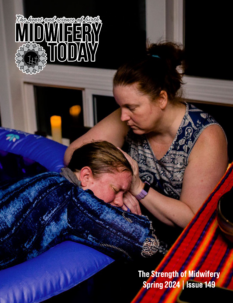
An Intimate Dance with Birthing Women
Editor’s note: This article first appeared in Midwifery Today, Issue 69, Spring 2004.
Join Midwifery Today Online Membership
When he was asked, “What is a friend?” Aristotle answered, “One soul inhabiting two bodies.”
When asked, “What is a doula?” Heather Mains answered, “One soul inhabiting two bodies.”
So rarely in our lives do we have the privilege to be in union—nonseparate from another with a shared intent or purpose. Such is the opportunity during labour and birth. We must take notice and give ourselves permission to engage in this type of intimacy.
In my work as a doula, I have three phases of my relationship with most of my pregnant clients.
We meet and discuss their plans for birth, I am present for the labours and births and we talk about them afterward, then I withdraw from their lives. This article explores the strikingly intimate relationship birth attendants often develop with women during childbirth. These phenomenally intense experiences are rarely analyzed and discussed in detail. What happens when a caregiver enters into the intimate time and space of childbirth with a woman? It is this aspect of the spiritual relationship and the articulation of this intimacy that is of particular interest here—a world of cohabitation rather than control.
In the Beginning: We Meet
Many people, including prospective clients, have little idea of what I do as a doula. Most assume it is the equivalent role of a midwife. Some assume it is the equivalent role of an obstetrician. It is similar, but not quite like either. It is different not only in its limitations of practice, but in its practical scope and continuity of care. A doula is a woman who helps other women in the transition to motherhood. Specifically, a birth doula provides physical, emotional, informational support and resources to pregnant women and their families in preparation for and during childbirth. A doula is knowledgeable about physiology of birth, medical terms and common medical approaches to birth, as well as alternative options to these medical approaches. She is experienced, having witnessed birth. She is supportive, understanding the phases of labour and postpartum and the variety of reaction women may have to these experiences. The role of the doula can be filled by anyone with compassion and sensibilities to childbirth: a woman’s mother, her sister, her partner, a nurse, a midwife or (less frequently these days) a physician.
A doula, however, is not clinically responsible for the woman and the baby in birth. She conducts no blood pressure readings, orders no screenings or tests and she does not check cervical dilation. Being a doula is not about the practice of allopathic medicine. In addition, a doula does not catch babies, listen to heart rates, or manipulate babies in utero. She does not practice midwifery.
In fact, after a decade as a doula, I have moved from considering myself primarily a physical and emotional support to women as they give birth, to a spiritual dance partner. But more on this later.
A Call to Care
Many people I have met see the doula’s role as an admirable pursuit, a kind of social “role model.” The role possesses an intangible attractiveness, a caring (or some refer to it as a loving) for other women at a time of need. The practices involving birth are referred to as “a calling”—a need, obligation or passion that draws one to adopt the role. Some doulas see themselves fulfilling a need expressed by pregnant women. They see themselves as putting compassion, contact and support back into medicalized childbirth. A few doulas want to “correct” birth after a bad personal experience by joining other women at birth. And others simply want to help other women experience the wondrousness of birth. The pursuit is a desire to “be” with women when they are vulnerable.
To be a doula is a privileged position; it is the position of witnessing the beginning of a life, of being at the miracle of birth. It includes a physical connection with the mystery of life coming into being, of being present at the point of the “suddenness of the miracle.” It is the rare occasion of being present when there is a shift from knowing the baby is inside for nine months to actually experiencing its transition into “a present being.”
Becoming a doula requires building relationships involving the deepest of trust. People trust us for our skill, knowledge and experience. People trust us, placing their children in our hands. But perhaps more significantly, people admire us for being able to be with women while they are in pain—a time when women are at their most vulnerable, a time when they are most feared by others.
The capacity to be with people in pain arises from our willingness to face fear with others. In North American culture, we often don’t listen to others express their fears. We tend to deny, ignore and distract, rather than connect with the fears others hold. Doulas are inevitably presented with fears of pregnant women. Listening to and coping with the fears of others is one aspect of being a doula that is both a privilege and a challenge.
The “secret” of birth is something others believe that we, as birth attendants, hold.
Witnessing childbirth is not a common experience in our culture, although women do it every day. The perspective that doulas enjoy is taboo, in a sense; we see birth as normal in a world that understands childbirth as trauma and torture needing intervention or something from which women need to be “delivered” by an outsider. Doulas trust in birth as a normal process. They trust the woman’s capacity to give birth normally.
The Middle: She Calls Me to Her
When a woman calls upon me as her birth doula, we have usually already started to build a relationship of trust. Most often we have met, discussed and planned before hand. The pregnant woman has developed her trust in me as a competent attendant in birth and I have developed my trust in her as a birthing woman. This is a solid foundation for the intimate journey that I accompany the woman on as she travels through the birth process. As we enter the birth process, I have occasion to meet the woman at her deepest depth. Birth is such an intense, intimate and vulnerable time for the mother-to-be.
Birth is a time of vulnerability and power. I can understand why some people say they don’t want strangers at their birth and they want to keep it private. The experience strips things bare: a woman’s body, her emotions, her fears. And if she is willing to share those, it leaves her naked.
Birth is vivid and visceral and vital.
Doulas have a choice when they are invited into this relationship. They have a wonderful opportunity to provide continuity of care as a single dedicated care provider. They can be with the woman regularly throughout the experiences of pregnancy and postpartum and constantly in attendance throughout the birth process. This is a unique position as caregiver. And few other care providers will meet with the woman on her turf—in her home, on her schedule, while she is wearing her own clothes.
The focus of each encounter between doula and mother-to-be is based on the pregnant woman’s personal needs. Once she has started labour, there is no paper work for the doula to do, no charting, no answering to others, just to the labouring woman. This dedication reinforces the relationship of trust between the woman and her doula; she is available at all times. This is quite different than the anonymous and distracted relationship a birthing woman might have with uniformed care providers from an institution.
When I connect with a woman during the intense times of her labour, when she indicates that she needs some support and lets me in, I am engaged in a dance with her—a dance of the most intense proportions. In fact, I do not like to use the words “support,” “facilitator” or even “guide” to describe what I do. They imply that the woman needs me in order to give birth. This is not necessarily the case. My role is not to control or direct her if she does ask for me. I prefer to say that I bear witness to her struggle and accompany her, encouraging her in her labor.
Flow of Time
At times, I can be drawn deeply into working with a woman at crucial times in her labour. Sometimes, it as if I am living the childbirth journey with her. Not the physical pain, no, but the intensity of her experiences, such as her fear or lack of direction, which are vital to the resolution of her labour. I “walk with her” as she moves to another level of coping. Upon reflection, I realize that I lose my sense of time and space as she does. In psychology, this experience has been referred to as “flow” (Csikszentmihalyi 1996). In religious studies (Grimes 1982) and anthropology disciplines (Turner 1977), this state of flow is manifest during the act of a ritual. When I see a woman focused and labouring well, I see it in terms of “flow” during the birthing ritual. This ritual experience of time (or the lack of it) seems to be a moment of “sustained present time” shared between us.
In my research, I equate this aspect of ritual time (as Grimes calls it) to being in trance. Frequently, during the woman’s labour, I engage in a total focus on her experience. Everything that does not pertain to supporting her in the moment needs to fall away. Whether she experiences a contraction as it occurs or the rest period between, the focus is defined by the woman’s experience. Ritual time is the opportunity to experience parts of labour outside of linear time. When a woman allows herself to fully engage in what she is doing, she can feel at ease with living time “in the present.” By “staying in the moment,” she is better able to cope with the length and intensity of labour because during those moments, she no longer directs, plans, organises, anticipates, recalls or judges her labour. Instead, all her focus and energy is given over to the task of doing labour without anticipation for the future and concern of the past. Reports of the women in my study (Mains 2002) indicate that during this state, a woman can move through hours of labour with less suffering. As a doula, journeying with her in this manner is a true privilege.
Rhythm
During this time, we start to move in sync, intuitively, in rhythm—timeless. I am at liberty to move in and out of her timeless journey in order to anticipate her needs. I grab a cool cloth or stroke her back; I coo words of encouragement or offer a sip of water; I remind her of the strength she is demonstrating; I ask her “what is going through” her mind for hints of her state, her needs, or a discomfort that I might address; I rock with her.
Then I fall back into the journey, breathing with her, talking her through the gateways of a strong sensation, touching her with a breath or a hand or my words, walking with her.
One woman I was a doula for described this timelessness as a state of grace. Suzanna, the mother of Lilly, said: “I was given the opportunity to experience natural childbirth. It’s not an experience you are ever in control of. You can’t control how it’s going to go. You can do all the yoga, all the hypnotherapy, all the everything …and it’s still a mystery. It’s going to be what it is. I had no recollection of time … I had no sense of time. I had grace.”
Walking with Her
In religious terms, I suppose that I “walk through the valley of the shadow of the death” (23 Psalm) with a woman, and by this act, she draws strength from my presence. The “shadow of death” is not a physical death in this case, but a losing and regaining of her self as she is “pushed to the edge,” as Suzanna called it. The term “shadow” fully captures the mood and limitation felt by many women during childbirth. A gray, hopeless shadow is cast and for a moment (or at various moments) the mother-to-be does not see a future for herself; she is so consumed by the intensity of her experience. “Shadow” carries the notion of impending death without implying its certain finality. Likewise the term “valley” reflects on the lowness of the depth of experience. As a doula, I must walk carefully at these moments, listening and watching, as normal verbal communication is often beyond her capacity at this point. At these moments, I must trust that I am in step with her and walk with her when she wishes.
My experience of this journey with Suzanna was an especially rare one because it was sustained over a long period during her hospital labour. It is rare that I am granted an opportunity to engage with women on this level without interruption in a hospital. In this case, the doctor was our “gatekeeper,” standing at the foot of the bed, watching. It was an honour to do this work of labour with Suzanna. We had a dynamic and palpable connection. We also had the pleasure of talking about her labour in a later interview that we had.
During the interview, Suzanna commented on the powerfulness of this most recent birth experience saying, “There is something extraordinary about experiencing that level of intensity and coming through to the other side. It’s such a strange thing to say, but I wouldn’t have missed it. I would not have not had that experience!”
This level of intensity requires two things of me as a caregiver: 1) I cannot be afraid and 2) I must hear her when she feels afraid. It is my job to acknowledge her pain, but separate it from suffering. It is my job to address fear as a part of birth, but not to feed the fear. As a doula, my job is to connect with the fears a woman has, not to ignore, avoid, mask or drug them. Once addressed, the fear shifts and gives rise to witnessing that same level of intensity and yet, to see something other than suffering. Ina May Gaskin, a grandmother of modern midwifery in the U.S. and author of Spiritual Midwifery, reminds us that there is no place for fear in the birth room (1990). So, we walk together in labour, the mother-to-be and I, intensely feeling, but not suffering.
The End: We Part Ways
After the baby is born the mother and I are back in real time. Back to social divisiveness, into a severed relationship. Our intimacy and intensely shared experience has vanished. I drop out of the triangle of the new family, often never to be seen again. Not even to know the child as he or she grows out of infancy and becomes someone very different. In traditional societies, and in the past, caregivers do not disappear from the lives of mother and baby. Midwives and healers serve families from the cradle to the grave. “Modern” life brings about the parting of ways of caregiver and mother. Strangely, this is not difficult for me; I had a vital experience and can respect the norms of being hired to do a job and when the job is over, to leave. But the mom—it’s harder for her, perhaps.
There is no space in our culture for the mom to talk about the visceral experience of birth. No one wants to hear her. The doula is disappearing from her life. Doctors are not interested (read: have no time) to listen to spiritual growth or emotional challenges. The attending nurse is usually not seen again (in fact, often the nurse was unknown to the mom when she entered the birth room). Frequently, there are as many as five to six attending nurses in a large, teaching hospital. They dwell behind the mask of confidentiality and anonymous institutional existence. How could a new mom share the intensity of her story with someone so removed from her?
And so the story of this type of intimacy and intensity never really gets told. Maybe that’s the secret of birth. It’s a secret between the mother and the caregiver who is totally in tune with her, encouraged her, walked with her, was with her, witnessed her as she went through the birth process.
Postscript
I notice as I develop this line of thinking that I have not addressed the baby’s role in the birth. I do not wish to ignore the baby. Suzanna fully believed that her baby and her communication with her baby during labour contributed to the kind of birth experience she had with Lilly. But I suggest in this essay that the mystery of birth is not just the sudden presence of a human being previously in utero or the moment of a first breath. It is also the mysterious and awe-provoking power that a woman can experience during the birthing process. As caregivers, we have an opportunity to accept invitations to be part of that process and to honor that process. It is that part of the secret of childbirth that I hope I have articulated for you.
References:
- Csikszentmihalyi, M. (1996). Creativity: Flow and the Psychology of Discovery and Invention (1st ed.). New York: Harper Collins Publishers.
- Gaskin, I. M. (1990). Spiritual Midwifery (3rd ed.). Summertown, TN: Book Pub. Co.
- Grimes, R. L. (1982). Beginnings in Ritual Studies. Washington, D.C.: University Press of America.
- Mains, H. (2002). The Art of Giving Birth: The Power of Ritualizing. Unpublished Masters, York University, Toronto.
- Turner, V. (1977). Variations on a Theme of Liminality. In: S. Moore & B. Myerhoff (Eds.), Secular Ritual. Assen, The Netherlands: Van Gorcum.


















